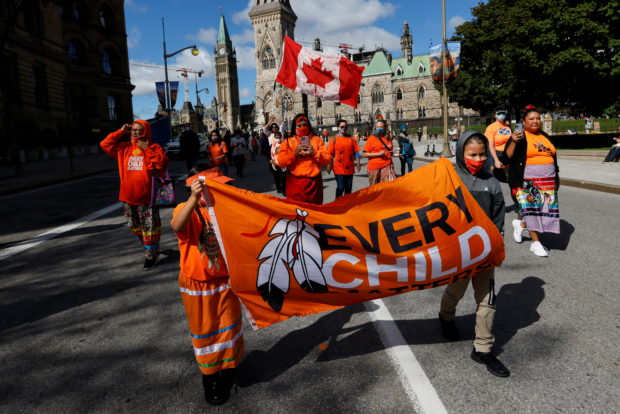
People march from Parliament Hill during Canada’s first National Day for Truth and Reconciliation, honouring the lost children and survivors of Indigenous residential schools, their families and communities, in Ottawa, Ontario, Canada September 30, 2021. REUTERS/Blair Gable
OTTAWA — Canada on Tuesday earmarked Can$40 billion ($31 billion) to compensate indigenous children who suffered discrimination in foster care, in a fiscal update touting a quicker-than-expected economic recovery from a pandemic slump.
The monies have been set aside to settle a lawsuit that found the government had underfunded indigenous children’s services compared to those for non-indigenous children.
Finance Minister Chrystia Freeland said half of the funds would go to compensate children and their families and the other half would be spent on reforming the system.
“We know that paying our historic debt to indigenous peoples is paramount and that we must act to ensure these injustices do not happen again,” she said in a speech.
A tribunal in 2019 ordered the government to pay Can$40,000 to each child removed from their parents after 2006 and placed in foster care outside of their indigenous community.
Ottawa asked a federal court of appeal in September to overturn the ruling, while it sought a negotiated deal. Those talks are still ongoing.
Against this backdrop, discoveries of more than 1,300 unmarked graves at former indigenous residential schools — where many students were malnourished and abused — have put a spotlight on a push for reconciliation with Canada’s 1.7 million indigenous peoples.
“Money does not mean justice,” said Assembly of First Nations National Chief RoseAnne Archibald of the earmarked compensation after it was leaked Monday. “However, it signals that we are on the healing path forward.”
In the fiscal update, Freeland also outlined a tapering of pandemic aid, noting that “Canada has largely recovered from the economic damage inflicted by Covid-19 and is poised for robust growth in the months to come.”
Three million jobs lost at the start of the pandemic have been recouped and economic growth is near pre-pandemic levels.
After doling out more than half a trillion dollars in Covid-19 aid over the past two years, the government is now proposing to focus aid on hardest hit sectors and on fighting the Omicron variant, while introducing paid sick leave for workers, as well as funding and tax credits for improved indoor air ventilation to reduce virus transmission.
“Keeping the Canadian economy on life support as we went into Covid-19 hibernation was expensive,” Freeland said.
“Our goal was to prevent economic scarring,” she added. “We wanted to emerge from this with our economic muscle intact; ready, as a country, to come roaring back.”
Parliament must still have its say on the new outlays.
Opposition parties have raised concerns about government spending fueling inflation, but also called for continued Covid aid.
This year’s deficit is projected to fall slightly from an April budget forecast to Can$327.7 billion, while the national debt is set to reach Can$1,048.7 billion, or 47.6 percent of GDP.
Growth is also expected to be lower at 4.6 percent.
RELATED STORIES
Remains of 215 children found at former indigenous school site in Canada
Canada marks first national holiday for indigenous reconciliation
MOST READ
LATEST STORIES